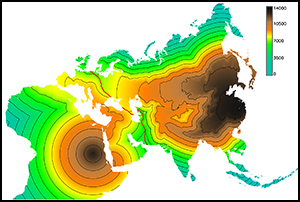Crossref Citations
This article has been cited by the following publications. This list is generated based on data provided by
Crossref.
Dunne, Julie
Mercuri, Anna Maria
Evershed, Richard P.
Bruni, Silvia
and
di Lernia, Savino
2016.
Earliest direct evidence of plant processing in prehistoric Saharan pottery.
Nature Plants,
Vol. 3,
Issue. 1,
Jordan, Peter
and
Weber, Andrzej
2016.
Persistent foragers: New insights into Holocene hunter-gatherer archaeology in northern Eurasia.
Quaternary International,
Vol. 419,
Issue. ,
p.
1.
Gibbs, Kevin
Isaksson, Sven
Craig, Oliver E.
Lucquin, Alexandre
Grishchenko, Vyacheslav A.
Farrell, Tom F.G.
Thompson, Anu
Kato, Hirofumi
Vasilevski, Alexander A.
and
Jordan, Peter D.
2017.
Exploring the emergence of an ‘Aquatic’ Neolithic in the Russian Far East: organic residue analysis of early hunter-gatherer pottery from Sakhalin Island.
Antiquity,
Vol. 91,
Issue. 360,
p.
1484.
González Carretero, Lara
Wollstonecroft, Michèle
and
Fuller, Dorian Q.
2017.
A methodological approach to the study of archaeological cereal meals: a case study at Çatalhöyük East (Turkey).
Vegetation History and Archaeobotany,
Vol. 26,
Issue. 4,
p.
415.
Shoda, Shinya
Lucquin, Alexandre
Ahn, Jae-ho
Hwang, Chul-joo
and
Craig, Oliver E.
2017.
Pottery use by early Holocene hunter-gatherers of the Korean peninsula closely linked with the exploitation of marine resources.
Quaternary Science Reviews,
Vol. 170,
Issue. ,
p.
164.
Kuzmin, Yaroslav V.
2017.
The origins of pottery in East Asia and neighboring regions: An analysis based on radiocarbon data.
Quaternary International,
Vol. 441,
Issue. ,
p.
29.
Tsydenova, Natalia
Andreeva, Darima
and
Zech, Wolfgang
2017.
Early pottery in Transbaikal Siberia: New data from Krasnaya Gorka.
Quaternary International,
Vol. 441,
Issue. ,
p.
81.
Gravel-Miguel, Claudine
and
Wren, Colin D.
2018.
Agent-based least-cost path analysis and the diffusion of Cantabrian Lower Magdalenian engraved scapulae.
Journal of Archaeological Science,
Vol. 99,
Issue. ,
p.
1.
Fuller, Dorian Q
and
Carretero, Lara Gonzalez
2018.
The Archaeology of Neolithic Cooking Traditions: Archaeobotanical Approaches to Baking, Boiling and Fermenting.
Archaeology International,
Vol. 21,
Issue. 1,
Hendy, Jessica
Colonese, Andre C.
Franz, Ingmar
Fernandes, Ricardo
Fischer, Roman
Orton, David
Lucquin, Alexandre
Spindler, Luke
Anvari, Jana
Stroud, Elizabeth
Biehl, Peter F.
Speller, Camilla
Boivin, Nicole
Mackie, Meaghan
Jersie-Christensen, Rosa R.
Olsen, Jesper V.
Collins, Matthew J.
Craig, Oliver E.
and
Rosenstock, Eva
2018.
Ancient proteins from ceramic vessels at Çatalhöyük West reveal the hidden cuisine of early farmers.
Nature Communications,
Vol. 9,
Issue. 1,
Jordan, Peter
and
Gibbs, Kevin
2018.
Ceramics in Circumpolar Prehistory.
p.
1.
Lucquin, Alexandre
Robson, Harry K.
Eley, Yvette
Shoda, Shinya
Veltcheva, Dessislava
Gibbs, Kevin
Heron, Carl P.
Isaksson, Sven
Nishida, Yastami
Taniguchi, Yasuhiro
Nakajima, Shōta
Kobayashi, Kenichi
Jordan, Peter
Kaner, Simon
and
Craig, Oliver E.
2018.
The impact of environmental change on the use of early pottery by East Asian hunter-gatherers.
Proceedings of the National Academy of Sciences,
Vol. 115,
Issue. 31,
p.
7931.
Feuchtwang, Stephen
and
Rowlands, Michael
2019.
Civilisation Recast.
Özdoğan, Mehmet
2019.
Eastern Mediterranean Port Cities.
p.
29.
Piezonka, Henny
Kosinskaya, Lyubov’
Dubovtseva, Ekaterina
Chemyakin, Yuri
Enshin, Dmitri
Hartz, Sönke
Kovaleva, Valentina
Panina, Svetlana
Savchenko, Svetlana
Skochina, Svetlana
Terberger, Thomas
Zakh, Viktor
Zhilin, Mikhail
and
Zykov, Aleksey
2020.
The emergence of hunter-gatherer pottery in the Urals and West Siberia: New dating and stable isotope evidence.
Journal of Archaeological Science,
Vol. 116,
Issue. ,
p.
105100.
Nieuwenhuyse, Olivier
2020.
Consciousness, Creativity, and Self at the Dawn of Settled Life.
p.
168.
Bondetti, Manon
Lucquin, Alexandre
Savel'ev, Nikolai A.
Weber, Andrzej W.
Craig, Oliver E.
and
Jordan, Peter D.
2020.
Resource processing, early pottery and the emergence of Kitoi culture in Cis-Baikal: Insights from lipid residue analysis of an Early Neolithic ceramic assemblage from the Gorelyi Les habitation site, Eastern Siberia.
Archaeological Research in Asia,
Vol. 24,
Issue. ,
p.
100225.
2020.
Consciousness, Creativity, and Self at the Dawn of Settled Life.
p.
151.
Phelps, Leanne N.
Chevalier, Manuel
Shanahan, Timothy M.
Aleman, Julie C.
Courtney‐Mustaphi, Colin
Kiahtipes, Christopher Albert
Broennimann, Oliver
Marchant, Rob
Shekeine, John
Quick, Lynne J.
Davis, Basil A. S.
Guisan, Antoine
and
Manning, Katie
2020.
Asymmetric response of forest and grassy biomes to climate variability across the African Humid Period: influenced by anthropogenic disturbance?.
Ecography,
Vol. 43,
Issue. 8,
p.
1118.
Admiraal, Marjolein
Lucquin, Alexandre
von Tersch, Matthew
Craig, Oliver E.
and
Jordan, Peter D.
2020.
The adoption of pottery on Kodiak Island: Insights from organic residue analysis.
Quaternary International,
Vol. 554,
Issue. ,
p.
128.



